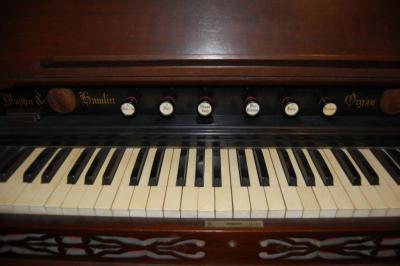

As such, the hand-pumped harmonium is typically only capable of producing singular melodic lines, since only one hand is available to control the keys.

In hand-pumped harmoniums, the player is usually seated on the floor and pumps the bellows with their left hand while playing melodic lines with their right hand. The harmonium is set on the ground, and the player sits in front of the instrument. The accordion is also held against the player’s chest and the bellows is pumped horizontally between the two hands. The harmonium employs only one keyboard that can be played with both hands as in a traditional organ, whereas the accordion splits its melodic and harmonic duties between the right and left hands, respectively, via a keyboard and a set of buttons on either side of the instrument. Although this mechanism is similar to that employed in accordions, the way in which the two instruments are played is vastly different. Harmoniums employ a bellows that must be pumped in order to fill the reservoir with a constant supply of air that is released to the reeds when a key is depressed. Throughout the nineteenth century, harmoniums were most typically found in small churches and in private residences, with some even serving as mere pieces of furniture on account of the quality of craftsmanship that characterized much of their cabinetry.
#Mason hamlin pump organ portable
Harmoniums in particular were made to be self-contained and portable instruments that could be carried to various venues while still providing a tone of sufficient volume. Although most reed organs cannot match the dynamic range and power of the average pipe organ, even the smallest of reed organs are still recognized for their ability to carry and project their tone in solo contexts. Operation/Function Pipe organs are characterized by their commanding presence, capable of filling even the largest of cathedrals with their sound. The company established itself in 1854 and developed a longstanding reputation for quality that began with the first type of instrument it focused on: the harmonium.

The maker of this one, Mason & Hamlin, is one of America’s oldest instrument manufacturers. Like pipe organs, harmoniums make music with bellows, a reservoir and valves connected to a keyboard, but they use much smaller metal reeds instead of pipes. The portable, compact harmonium-a type of reed organ-was popular with travelling priests and missionaries in the late 19th and early 20th centuries.


 0 kommentar(er)
0 kommentar(er)
